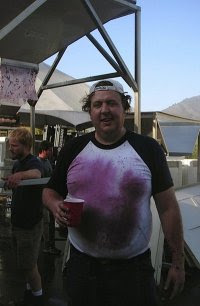 So Day 3, its time to see what kind of "numbers" the Rosella's is giving us this year. While at the end of the day wine comes down to taste, there are certain numbers that help guide a winemaker to get the most out of the grapes as possible. From what I have learned so far, it is far more important to see the "numbers" as a guidepost, your sherpa if you will, on your expedition to craft the best wine possible from the grapes you have in front of you, rather than as a "be all, end all" recipe for wine.
So Day 3, its time to see what kind of "numbers" the Rosella's is giving us this year. While at the end of the day wine comes down to taste, there are certain numbers that help guide a winemaker to get the most out of the grapes as possible. From what I have learned so far, it is far more important to see the "numbers" as a guidepost, your sherpa if you will, on your expedition to craft the best wine possible from the grapes you have in front of you, rather than as a "be all, end all" recipe for wine.With this is mind, Lydia (Kosta Browne's resident enologist) and I ran what you call a "juice panel". A "Juice Panel" gives the wine maker an idea of the amount and types of sugar, acids, and nutrients available for the yeasts to do their work. We ran several types of tests. The first was a simple Brix reading with a pocket refractometer.
 As you can see here, we have a nice Brix reading of 27.1 which is right in the sweet spot of tasty wine. Brix is a pretty good approximation for the sugar content of the juice and thus the amount of "fuel" we have available for the yeasties. 1 Degree of Brix will produce somewhere around 0.55% alcohol so this Rosella's juice will give us a projected alcohol of 14.5%. Just about where you want it.
As you can see here, we have a nice Brix reading of 27.1 which is right in the sweet spot of tasty wine. Brix is a pretty good approximation for the sugar content of the juice and thus the amount of "fuel" we have available for the yeasties. 1 Degree of Brix will produce somewhere around 0.55% alcohol so this Rosella's juice will give us a projected alcohol of 14.5%. Just about where you want it.We then run some acid trials where we slowly titrate NaOH (Sodium Hydroxide) into a sample of the juice to see its buffering capacity. Sodium Hydoroxide reacts with the acid in the wine and the amount of NaOH that the juice sample can take for any given pH target (say pH 3.50) gives us an idea of how much the juice will be affected by any change in its acid levels.
We also run some tests to find out how much YANC the juice has. YANC is a nice acronym for Yeast Assimilable Nitrogen Content. In order to live free and multiply our yeasties need nutrients, mainly in the form of nitrogen compounds, in order to healthily digest the sugars in the grapes into alcohol. Too little YANC and the yeast struggle, often giving off odors of ethyl acetate, and hydrogen sulfide and worst case scenario you get a "stuck" fermentation where all the yeast die before all the sugar is converted to alcohol. Trust me, you don't want that to happen. As you can imagine knowing how much YANC is available is pretty helpful to a wine maker (and there are several things we can add to the juice to increase the levels -- a topic for another time).
All in all, the Rosella's juice looks in great shape and ready to make some killer Pinot. One more day of resting until we inoculate and get 2007 Rosella's underway.


No comments:
Post a Comment